有机光电材料
- 格式:doc
- 大小:67.50 KB
- 文档页数:8
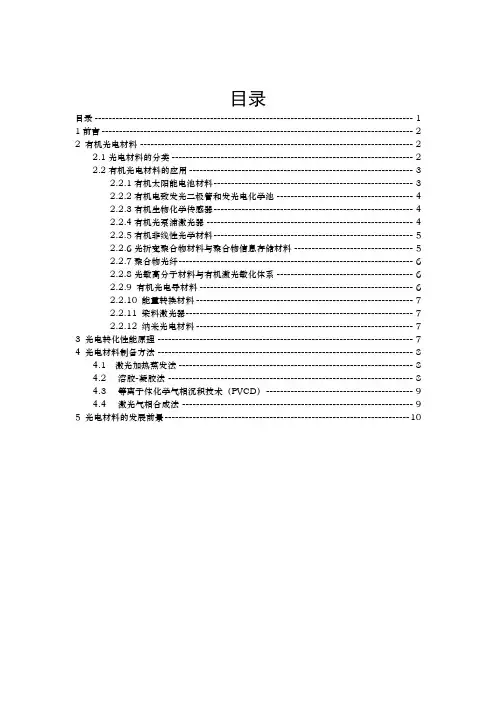
目录目录 ------------------------------------------------------------------------------------------- 1 1前言----------------------------------------------------------------------------------------- 2 2 有机光电材料 ------------------------------------------------------------------------------ 22.1光电材料的分类 --------------------------------------------------------------------- 22.2有机光电材料的应用 ---------------------------------------------------------------- 32.2.1有机太阳能电池材料--------------------------------------------------------- 32.2.2有机电致发光二极管和发光电化学池 --------------------------------------- 42.2.3有机生物化学传感器--------------------------------------------------------- 42.2.4有机光泵浦激光器 ----------------------------------------------------------- 42.2.5有机非线性光学材料--------------------------------------------------------- 52.2.6光折变聚合物材料与聚合物信息存储材料 ---------------------------------- 52.2.7聚合物光纤------------------------------------------------------------------- 62.2.8光敏高分子材料与有机激光敏化体系 --------------------------------------- 62.2.9 有机光电导材料 ------------------------------------------------------------- 62.2.10 能量转换材料 -------------------------------------------------------------- 72.2.11 染料激光器----------------------------------------------------------------- 72.2.12 纳米光电材料 -------------------------------------------------------------- 73 光电转化性能原理 ------------------------------------------------------------------------- 74 光电材料制备方法 ------------------------------------------------------------------------- 84.1 激光加热蒸发法 ------------------------------------------------------------------- 84.2 溶胶-凝胶法 ---------------------------------------------------------------------- 84.3 等离子体化学气相沉积技术(PVCD)------------------------------------------ 94.4 激光气相合成法 ------------------------------------------------------------------ 95 光电材料的发展前景---------------------------------------------------------------------- 101前言有机光电材料是一类具有光电活性的特殊有机材料。
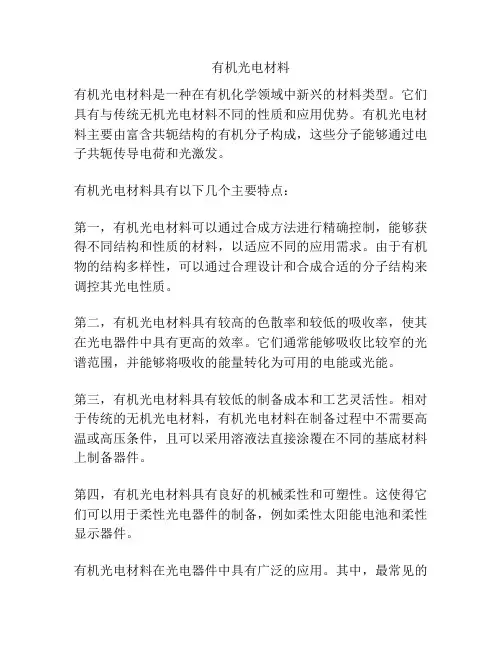
有机光电材料有机光电材料是一种在有机化学领域中新兴的材料类型。
它们具有与传统无机光电材料不同的性质和应用优势。
有机光电材料主要由富含共轭结构的有机分子构成,这些分子能够通过电子共轭传导电荷和光激发。
有机光电材料具有以下几个主要特点:第一,有机光电材料可以通过合成方法进行精确控制,能够获得不同结构和性质的材料,以适应不同的应用需求。
由于有机物的结构多样性,可以通过合理设计和合成合适的分子结构来调控其光电性质。
第二,有机光电材料具有较高的色散率和较低的吸收率,使其在光电器件中具有更高的效率。
它们通常能够吸收比较窄的光谱范围,并能够将吸收的能量转化为可用的电能或光能。
第三,有机光电材料具有较低的制备成本和工艺灵活性。
相对于传统的无机光电材料,有机光电材料在制备过程中不需要高温或高压条件,且可以采用溶液法直接涂覆在不同的基底材料上制备器件。
第四,有机光电材料具有良好的机械柔性和可塑性。
这使得它们可以用于柔性光电器件的制备,例如柔性太阳能电池和柔性显示器件。
有机光电材料在光电器件中具有广泛的应用。
其中,最常见的应用是有机太阳能电池。
有机太阳能电池采用有机光电材料作为吸光层,以吸收光能并将其转化为电能。
有机太阳能电池具有相对较高的光电能量转换效率,并且可以在低光照条件下进行工作。
此外,有机光电材料还可以用于有机发光二极管(OLED)、有机光电传感器、有机薄膜晶体管等器件的制备。
这些器件在显示、光通信、光检测等领域具有广泛的应用前景。
总的来说,有机光电材料作为一种新型的光电材料,在能源转换和信息显示等领域表现出良好的应用潜力。
随着对其性能和制备工艺的不断研究和改进,有机光电材料的性能将得到进一步提升,且其应用领域将不断扩大。
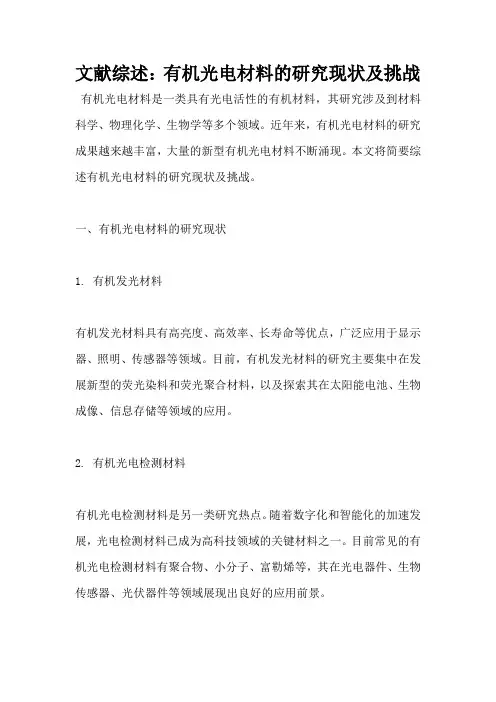
文献综述:有机光电材料的研究现状及挑战有机光电材料是一类具有光电活性的有机材料,其研究涉及到材料科学、物理化学、生物学等多个领域。
近年来,有机光电材料的研究成果越来越丰富,大量的新型有机光电材料不断涌现。
本文将简要综述有机光电材料的研究现状及挑战。
一、有机光电材料的研究现状1. 有机发光材料有机发光材料具有高亮度、高效率、长寿命等优点,广泛应用于显示器、照明、传感器等领域。
目前,有机发光材料的研究主要集中在发展新型的荧光染料和荧光聚合材料,以及探索其在太阳能电池、生物成像、信息存储等领域的应用。
2. 有机光电检测材料有机光电检测材料是另一类研究热点。
随着数字化和智能化的加速发展,光电检测材料已成为高科技领域的关键材料之一。
目前常见的有机光电检测材料有聚合物、小分子、富勒烯等,其在光电器件、生物传感器、光伏器件等领域展现出良好的应用前景。
3. 有机光催化材料有机光催化材料是指通过光催化反应来实现化学反应的材料。
在光催化材料领域,通过改变有机半导体材料的组成、晶体结构等方面来提高材料的光催化性能,从而实现更高效、更经济的应用。
此外,有机光催化材料还可以用于环境修复、污水处理、空气净化等领域。
二、有机光电材料的挑战1. 稳定性问题尽管有机光电材料具有许多优点,但其稳定性问题是限制其广泛应用的主要因素之一。
有机光电材料的稳定性主要受到环境因素(如温度、湿度、氧气)的影响,同时也与其自身的化学结构有关。
因此,如何提高有机光电材料的稳定性是其研究的重要方向。
2. 效率问题尽管有机光电材料的发光效率和光电转换效率较高,但在实际应用中仍存在效率问题。
这主要是由于有机光电材料的载流子传输性能和界面效应等问题引起的。
因此,如何提高有机光电材料的效率也是其研究的重要方向。
3. 制造成本问题有机光电材料的制造成本较高,这也是限制其广泛应用的原因之一。
因此,如何降低有机光电材料的制造成本,如通过改进制造工艺、优化器件结构等方法,也是其研究的重要方向。
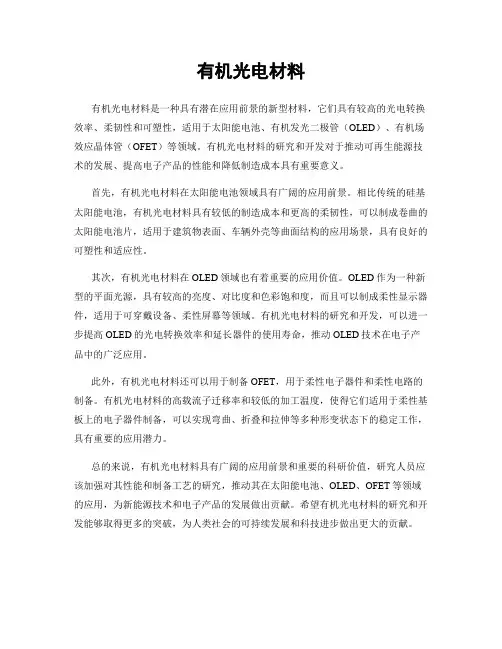
有机光电材料
有机光电材料是一种具有潜在应用前景的新型材料,它们具有较高的光电转换效率、柔韧性和可塑性,适用于太阳能电池、有机发光二极管(OLED)、有机场效应晶体管(OFET)等领域。
有机光电材料的研究和开发对于推动可再生能源技术的发展、提高电子产品的性能和降低制造成本具有重要意义。
首先,有机光电材料在太阳能电池领域具有广阔的应用前景。
相比传统的硅基太阳能电池,有机光电材料具有较低的制造成本和更高的柔韧性,可以制成卷曲的太阳能电池片,适用于建筑物表面、车辆外壳等曲面结构的应用场景,具有良好的可塑性和适应性。
其次,有机光电材料在OLED领域也有着重要的应用价值。
OLED作为一种新型的平面光源,具有较高的亮度、对比度和色彩饱和度,而且可以制成柔性显示器件,适用于可穿戴设备、柔性屏幕等领域。
有机光电材料的研究和开发,可以进一步提高OLED的光电转换效率和延长器件的使用寿命,推动OLED技术在电子产品中的广泛应用。
此外,有机光电材料还可以用于制备OFET,用于柔性电子器件和柔性电路的制备。
有机光电材料的高载流子迁移率和较低的加工温度,使得它们适用于柔性基板上的电子器件制备,可以实现弯曲、折叠和拉伸等多种形变状态下的稳定工作,具有重要的应用潜力。
总的来说,有机光电材料具有广阔的应用前景和重要的科研价值,研究人员应该加强对其性能和制备工艺的研究,推动其在太阳能电池、OLED、OFET等领域的应用,为新能源技术和电子产品的发展做出贡献。
希望有机光电材料的研究和开发能够取得更多的突破,为人类社会的可持续发展和科技进步做出更大的贡献。

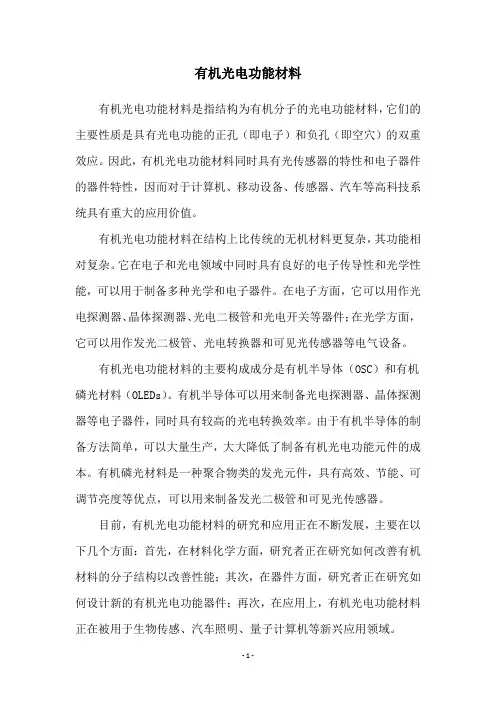
有机光电功能材料
有机光电功能材料是指结构为有机分子的光电功能材料,它们的主要性质是具有光电功能的正孔(即电子)和负孔(即空穴)的双重效应。
因此,有机光电功能材料同时具有光传感器的特性和电子器件的器件特性,因而对于计算机、移动设备、传感器、汽车等高科技系统具有重大的应用价值。
有机光电功能材料在结构上比传统的无机材料更复杂,其功能相对复杂。
它在电子和光电领域中同时具有良好的电子传导性和光学性能,可以用于制备多种光学和电子器件。
在电子方面,它可以用作光电探测器、晶体探测器、光电二极管和光电开关等器件;在光学方面,它可以用作发光二极管、光电转换器和可见光传感器等电气设备。
有机光电功能材料的主要构成成分是有机半导体(OSC)和有机磷光材料(OLEDs)。
有机半导体可以用来制备光电探测器、晶体探测器等电子器件,同时具有较高的光电转换效率。
由于有机半导体的制备方法简单,可以大量生产,大大降低了制备有机光电功能元件的成本。
有机磷光材料是一种聚合物类的发光元件,具有高效、节能、可调节亮度等优点,可以用来制备发光二极管和可见光传感器。
目前,有机光电功能材料的研究和应用正在不断发展,主要在以下几个方面:首先,在材料化学方面,研究者正在研究如何改善有机材料的分子结构以改善性能;其次,在器件方面,研究者正在研究如何设计新的有机光电功能器件;再次,在应用上,有机光电功能材料正在被用于生物传感、汽车照明、量子计算机等新兴应用领域。
总的来说,有机光电功能材料的发展具有重要的战略意义,可以有效地推动光电技术的发展,为能源、环境和人类和社会发展做出贡献。
随着有机光电功能材料的技术不断成熟,在新型能源、智能系统、交通安全等诸多领域发挥着重要作用。


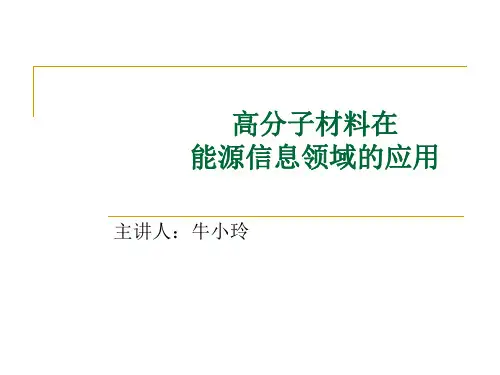
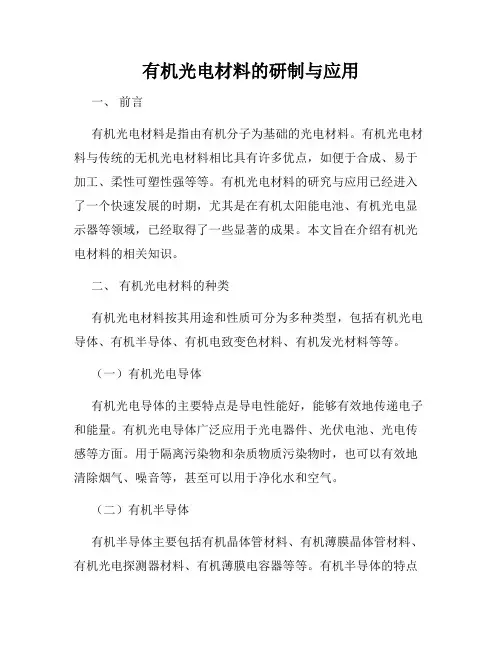
有机光电材料的研制与应用一、前言有机光电材料是指由有机分子为基础的光电材料。
有机光电材料与传统的无机光电材料相比具有许多优点,如便于合成、易于加工、柔性可塑性强等等。
有机光电材料的研究与应用已经进入了一个快速发展的时期,尤其是在有机太阳能电池、有机光电显示器等领域,已经取得了一些显著的成果。
本文旨在介绍有机光电材料的相关知识。
二、有机光电材料的种类有机光电材料按其用途和性质可分为多种类型,包括有机光电导体、有机半导体、有机电致变色材料、有机发光材料等等。
(一)有机光电导体有机光电导体的主要特点是导电性能好,能够有效地传递电子和能量。
有机光电导体广泛应用于光电器件、光伏电池、光电传感等方面。
用于隔离污染物和杂质物质污染物时,也可以有效地清除烟气、噪音等,甚至可以用于净化水和空气。
(二)有机半导体有机半导体主要包括有机晶体管材料、有机薄膜晶体管材料、有机光电探测器材料、有机薄膜电容器等等。
有机半导体的特点是具有一定的半导体特性,可用于制备高性能的光电器件和传感器等。
(三)有机电致变色材料有机电致变色材料是指通过电场作用改变材料的光学特性,例如改变其吸收波长、透明度、色度等等。
有机电致变色材料可应用于智能遮阳窗、信息显示器、光学开关等方面,有广泛的应用前景。
(四)有机发光材料有机发光材料具有发光性能,包括有机荧光材料、有机磷光材料、有机电致发光材料等。
有机发光材料可用于制备有机白光LED光源、柔性显示器等领域,被认为是未来新一代照明光源的发展方向。
三、有机光电材料的研制有机光电材料的研制主要包括化学合成、形态控制、材料运输等方面。
其中,化学合成是最为基础的研究领域,目前已经发展出了一系列的有机分子合成方法。
形态控制则是指通过化学方法、合理的晶化步骤等方式,控制材料的晶体形态、尺寸和界面性质等。
材料运输则是指研究材料在隧道、通道、管道等微观空间中的输运规律,可提高材料电子传输的效率。
四、有机光电材料的应用有机光电材料已经广泛应用于多个领域。
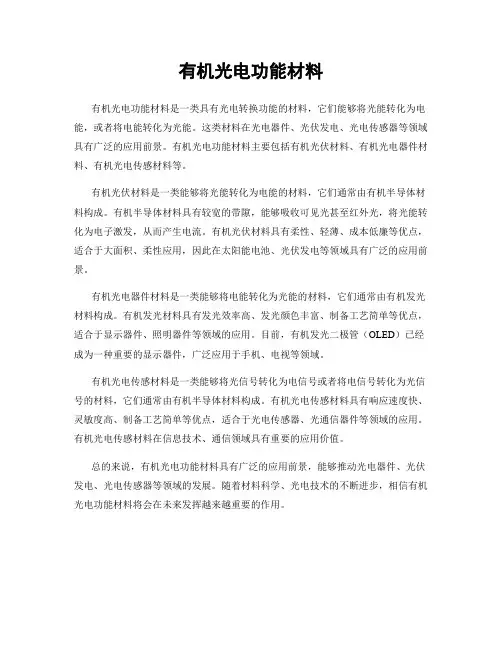
有机光电功能材料
有机光电功能材料是一类具有光电转换功能的材料,它们能够将光能转化为电能,或者将电能转化为光能。
这类材料在光电器件、光伏发电、光电传感器等领域具有广泛的应用前景。
有机光电功能材料主要包括有机光伏材料、有机光电器件材料、有机光电传感材料等。
有机光伏材料是一类能够将光能转化为电能的材料,它们通常由有机半导体材料构成。
有机半导体材料具有较宽的带隙,能够吸收可见光甚至红外光,将光能转化为电子激发,从而产生电流。
有机光伏材料具有柔性、轻薄、成本低廉等优点,适合于大面积、柔性应用,因此在太阳能电池、光伏发电等领域具有广泛的应用前景。
有机光电器件材料是一类能够将电能转化为光能的材料,它们通常由有机发光材料构成。
有机发光材料具有发光效率高、发光颜色丰富、制备工艺简单等优点,适合于显示器件、照明器件等领域的应用。
目前,有机发光二极管(OLED)已经成为一种重要的显示器件,广泛应用于手机、电视等领域。
有机光电传感材料是一类能够将光信号转化为电信号或者将电信号转化为光信号的材料,它们通常由有机半导体材料构成。
有机光电传感材料具有响应速度快、灵敏度高、制备工艺简单等优点,适合于光电传感器、光通信器件等领域的应用。
有机光电传感材料在信息技术、通信领域具有重要的应用价值。
总的来说,有机光电功能材料具有广泛的应用前景,能够推动光电器件、光伏发电、光电传感器等领域的发展。
随着材料科学、光电技术的不断进步,相信有机光电功能材料将会在未来发挥越来越重要的作用。
有机光电功能材料分类
有机光电功能材料是一类能够将光能转化为电能,或者在电场或电流作用下表现出光学效应的材料。
根据其功能和特性,有机光电功能材料可以分为以下几个主要分类:有机光电转换材料(Organic Photovoltaic Materials):这类材料可将光能转化为电能,常用于太阳能电池和光电探测器等光电转换设备。
它们通常由有机分子、有机半导体材料和聚合物构成。
有机发光材料(Organic Light-Emitting Materials):这类材料能够将电能转化为光能,广泛应用于有机发光二极管(OLED)等光电显示和照明设备。
常见的有机发光材料包括有机染料和聚合物。
光敏材料(Photosensitive Materials):这类材料在受到光照或电场激发后产生光学效应,用于光敏记录、激光打印、光刻制造等领域。
光敏材料常包含感光剂、波长转换剂和光致变色剂等。
有机光学材料(Organic Optical Materials):这类材料具有特殊的光学特性,包括透明性、折射率调控和非线性光学效应,并可用于光纤通信、光学薄膜和光学透镜等领域。
有机电致变色材料(Organic Electrochromic Materials):这类材料能够在电场刺激下实现颜色变化,可应用于电子纸、调光玻璃和显示器件等领域。
有机传感材料(Organic Sensing Materials):这类材料能够响应特定物理或化学刺激,如温度、湿度、气体和生物分子等,用于传感与检测应用,例如生物传感器和环境监测。
有机光电材料基础和器件设计原理概述光电材料是指具有光学和电学性能的材料,其中有机光电材料是一种由有机分子构成的材料,具有独特的光电性能和应用潜力。
本文将对有机光电材料的基础知识进行概述,包括其分类、性质以及在器件设计中的应用原理。
一、有机光电材料的分类和性质有机光电材料可以根据其结构和性质进行不同的分类。
最常见的分类方式是根据有机分子的结构,包括小分子有机光电材料和聚合物有机光电材料。
小分子有机光电材料是由有机分子构成的晶体或液体,具有高纯度和单一化学组成的优点。
这些材料具有良好的溶解性、易于纯化和加工,使得它们在有机光电器件中具有重要的应用潜力。
聚合物有机光电材料是由大量的有机分子构成的材料,具有高分子量和复杂的结构。
这些材料具有良好的柔性和可塑性,可通过改变其结构和化学组成来调节其光电性能。
有机光电材料具有许多优异的性质。
首先,它们具有宽范围的吸收和发射波长。
其次,它们具有可调节的光学和电学性能,如吸光度、发光效率、载流子迁移率等。
此外,有机光电材料还具有较低的成本、易于合成、可大面积制备和加工等特点,适于在柔性电子、光伏等领域应用。
二、有机光电器件的设计原理有机光电器件是利用有机光电材料制备的电子器件,包括有机太阳能电池、有机发光二极管、有机场效应晶体管等。
这些器件的设计原理主要涉及有机光电材料的光电转换过程。
有机太阳能电池是一种将光能转化为电能的器件,其设计原理基于光生电荷分离和电荷输运的过程。
当有机光电材料吸收光子能量时,光生载流子会在有机材料内部生成并分离,形成正负电荷。
通过调控有机材料的能带结构和界面的优化,可以有效提高载流子的分离效率和迁移率,从而提高太阳能电池的效率。
有机发光二极管是一种将电能转化为光能的器件,其设计原理基于电子和空穴在材料中复合并发光的过程。
通过选择合适的有机材料和调控其能带结构,可以实现电子从材料的低能级跃迁到高能级并与空穴复合,产生发光效应。
通过控制有机材料的能带结构和调节外加电压,可以实现不同颜色和亮度的发光。
有机光电材料的研究和应用有机光电材料是一种越来越受到关注的材料,它具有高效率、多功能、可调控性强等特点,广泛应用于光电器件、光伏、生物医药、光通信等领域。
本文从有机光电材料的性质、制备、应用等方面进行论述。
一、有机光电材料的基本性质有机光电材料是一种由有机分子构成的材料,具有一系列的电学、光学、磁学、化学等特殊性质。
其中,光学性质是最为突出的,它包括吸收、发射、产生光电荷的能力等。
有机光电材料的光谱吸收特性与它们的能带结构、分子构型、宏观形态等有关。
由于其分子结构的可调和和分子间的间隔效应,它们比无机光电材料拥有更为灵活和可控的吸收特性。
同时,它们还具有狭缝结构和电荷转移的特征,使得有机光电器件在光谱响应范围、量子效率、内部量子效率等方面更加灵活和可调控。
二、有机光电材料的制备和表征制备有机光电材料的方法主要包括化学合成法、流水生长法、自组装法等。
其中化学合成法是最常用的方式,通过反应原料加成或成环反应可实现材料的定向设计和结构调控,使得有机材料的宏观形态和微观结构都可以精准控制。
表征有机光电材料的方法主要有透射电子显微镜、扫描电子显微镜、原子力显微镜、拉曼光谱、电子能谱等。
它们可以从不同角度对材料的表面结构、粒径、晶体结构等进行分析,为制备和应用提供依据。
三、有机光电材料在光电器件中的应用1. 有机光电转换器件有机光电转换器件是将光能、电能、热能进行相互转换的重要器件。
它们主要包括有机太阳能电池、有机电致发光器等。
有机太阳能电池主要是利用高分子、小分子、共轭聚合物等有机材料的发光发电机理,实现曲线光谱响应、高效能、大面积制备等功能。
而有机电致发光器则是基于有机材料的发光性能和电致发光现象,实现高亮、高分辨率、宽光谱响应等特点。
2. 有机光电存储器件有机光电存储器件是利用有机分子间的载流子传输和电荷储存机制实现数据存储和读出。
这类器件主要是基于有机场效应晶体管、有机电容纸等材料实现的。
它们具有储存器件分子设计多样性、掩模化制备、高灵敏度、低功耗等优势,在信息存储、密码学、人工智能等方面具有广阔的应用前景。
新型有机光电材料的研究一、引言新型有机光电材料因其优异的光电性能、可调的化学结构以及可大规模合成等特点,已经成为现代光电材料领域的热点研究方向。
本文将从有机光电材料的概念、分类、合成方法、性质以及应用等方面进行论述。
二、有机光电材料的概念及分类有机光电材料是指在有机分子体系中具有光电性质的材料,可以将其分为发光材料和光电传感材料两大类。
1.发光材料发光材料是指具有发光性能的有机光电材料,可以将其分为荧光材料和磷光材料两大类。
荧光材料是指可以通过电子激发至激发态,再从激发态退回到基态时发出荧光的材料,常见的代表有荧光染料、发光二极管等。
磷光材料是指可以通过分子激发,从激发态通过磷光辐射过程发光的材料,其优点是有较长的寿命以及在发光过程中不伴随能量损耗,是一种广泛应用在发光显示和光电器件中的材料。
2.光电传感材料光电传感材料是指能够将光信号转化为电信号的有机光电材料,可分为吸光光电传感材料和荧光光电传感材料两种。
吸光光电传感材料是指通过吸收特定波长的光,使分子发生电荷转移或电子激发,从而产生特定的电信号。
而荧光光电传感材料则是通过与分子内或周围某种物质发生特定作用,使其荧光特性发生变化,从而接收电信号。
三、有机光电材料的合成方法1.有机小分子材料的合成方法有机小分子材料的合成方法包括热力学方法和动力学方法两种。
(1)热力学方法热力学方法是指通过调节反应条件,在核心分子上连续引入相同或不同的分支基团,从而构建出具有分支结构的传感分子。
常见的热力学途径包括模板法、聚附加反应法、核糖核酸单体化学合成法等。
(2)动力学方法动力学方法是指利用反应物分子间相互作用来构建发光基体,使得材料的光电性能随着反应过程的进行而逐步调控。
常见的动力学方法包括自组装、表面改性、剪切反应等。
2.聚合物材料的合成方法聚合物材料的合成方法包括开环聚合、自由基聚合、离子聚合、电子转移聚合、轮廓线聚合、协同聚合、界面聚合等多种方法。
(1)开环聚合开环聚合是一种通过环富集的机理,将环异构化嵌入到聚合物主链中来合成亚稳态聚合物的方法。
有机光电材料的发展现状与应用前景随着近年来科技的快速发展,越来越多的科学家开始关注有机光电材料的研究,这个领域的突破使得很多新型电子应用和设备得以实现。
本文将从有机光电材料的概念、基本工作原理及其发展历程、应用前景等方面阐述其发展现状及未来前景。
一、有机光电材料的概念有机光电材料是通过有机化学合成或高分子化学方法制备而成的,它可以在某些电子场合实现光电转换功能的一类材料。
其主要特征是含有能级分明、轻质低毒、易制备、价格低廉、柔性可弯曲等工艺重要优势。
因此,有机光电材料具有与传统材料不同的特点,可以更灵活地满足人们的需求。
这种新型材料不仅可以应用于光电器件、通讯、照明等方面,也可以用于制作灵活柔性的显示器、太阳能电池等。
二、有机光电材料的基本工作原理及其发展历程有机光电材料的工作原理比较简单,主要是在分子层级上调节电子结构,控制转移和传输过程,使其能够把光能成功转换为电能。
这种光电转换的原理和传统半导体材料不同,但是它可以兼容传统的半导体材料,非常适合于薄膜制备。
有机光电材料的发展历程可以追溯到二十世纪初,最早是法国的卢米耶尔教授使用红蒜素合成有机半导体材料,并且发现了它的导电性。
而真正意义上的有机光电材料发展则是在1977年,日本的奈良高彦教授所发明的H2Pc光电材料,该材料成功应用于极薄电极的太阳能电池,具有小体积、轻质化、柔性可弯曲等特点。
在此之后,人们开始意识到有机光电材料的潜在价值,开始大量的研究和开发。
目前为止,有机光电材料的研究涵盖了有机光电器件、有机太阳能电池、有机场效应晶体管、有机光控制激光器等众多领域,其中以有机太阳能电池的应用最为广泛。
三、有机光电材料的应用前景由于有机光电材料可以以低成本、高效、柔性、轻量化的方式制备光电器件,以及其优异深远的应用前景使得其广泛被研究应用于太阳能电池、有机发光器件、光电传感器等领域。
有机太阳能电池是有机光电材料应用最为广泛的领域,其具有轻质、低成本、环保等优点。
有机光电功能材料的研究与应用随着科学技术的不断进步和发展,有机光电功能材料的研究与应用在各个领域都取得了重大突破。
有机光电功能材料是指由有机化合物构成的具有光电性质的材料,其独特的性能使其在光电器件、光传感和光催化等领域具有广泛的应用前景。
一、有机光电功能材料的特性有机光电功能材料具有多种特性,包括较高的光吸收和发射效率、宽光谱的吸收和发射范围、可调控的光学性质、易于合成和加工等。
这些特性使得有机光电功能材料在光电器件中具有许多优势。
二、有机光电功能材料的研究进展在有机光电功能材料的研究中,物理、化学和工程等多个学科交叉融合,取得了许多重要的研究进展。
其中,有机光电材料的设计和合成是关键的一步。
通过合理的分子设计和合成方法,可以获得具有理想光电特性的有机材料。
此外,光物理、光化学和光电子学等研究领域的发展也推动了有机光电功能材料的研究进展。
三、有机光电功能材料在光电器件中的应用有机光电功能材料在光电器件中的应用前景广阔。
例如,有机光伏材料可转化光能成为电能,用于太阳能电池的制备;有机发光材料可作为有机发光二极管的发光层,用于显示器和照明等领域;有机电致发光材料可在有机电致发光器件中产生光,实现信息显示等功能。
在这些应用中,有机光电功能材料的特性发挥了重要的作用。
四、有机光电功能材料在光传感和光催化中的应用除了在光电器件中的应用,有机光电功能材料还在光传感和光催化等领域具有重要的应用价值。
有机光传感材料基于其对光的敏感性,可以用于检测环境中的有害物质以及生物分子等;有机光催化材料则通过光能转化为化学能,用于催化反应,如有机污染物的降解等。
这些应用不仅有助于环境保护,也对于生物医学和化学制药等领域有重要意义。
五、有机光电功能材料的挑战与展望尽管有机光电功能材料在各个领域都取得了重要突破,但仍存在着一些挑战。
例如,有机材料的稳定性和寿命较短,制约了它们在实际应用中的发展;有机光电器件的性能还有待进一步提高,以满足不同应用场景的需求。
Design, Fabrication, and Performance Investigation of OrganicOptoelectronic DevicesChong-an DiABSTRACTOrganic optoelectronic materials and devices, which is also called …plastic electronics‟, att rached focus attention in past decade due to their potential application in large area and low cost flexible displays, solid-state lighting, radio frequency identification (RFID) cards and electronic papers etc. As important parts of organic optoelectronic devices, organic light-emitting diodes (OLEDs), organic field-effect transistors (OFETs) and organic light-emitting transistors (OLEFTs) have made great achievements. The performance of these optoelectronic devices depends not only on the properties of the organic semiconductors involved, but is also dramatically affected by the properties of other functional layers and the nature of the interfaces present. Therefore, interface engineering, a novel approach towards high-performance OFETs, is a vital task for organic optoelectronic devices. Electrode/organic interfaces, dielectric/organic interfaces, organic/organic interfaces and organic/atmosphere interfaces are the three frequently reported interfaces in organic devices. In this dissertation, a systematic research has been carried out centering on the interface engineering of organic optoelectronic devices. With investigation of interface phenomenon and effective interface modification, dramatic decrease of power consumption and cost, obvious ehancement of device performance and improvement of stability are achieved. The main results are obtained as follows:1: Exploration of novel anode modification approach for OLEDs to reduce the power consumption and enhance the efficiency.Power consumption and light emitting property are the key parameters for the real application of organic light-emitting diodes. In fact, modification of electrodes is a widely applied approach to improve device performance of OLEDs since it can optimize the devices performance without change of organic functional materials. We demonstrated that the improvement of interface contact between ITO anode and organic semiconductor layer can be realized by the introduction of ultrathinhexadecafluoro copper phthalocyanine (F16CuPc) layer. Besides, The modification brings on formation of dipole layer on the ITO surface, which in turn leads to workfunction enhancement of ITO anode and dramatic decrease of hole injection barrier. With device design and optimization, we fabricated high performance low-operation voltage single-layer, double-layer and multi-layer OLEDs with tris(8-quinolinolato)aluminum (Alq3) as emissive layer. For the single layer Alq3 devices, the modification of the anode results in the significant enhancement in the current efficiency by about 30 times. The operation voltage decrease obviously for double layer devices, with minimum turn-on voltage of 2.6 V. As for multilayer OLEDs, the maximum current efficiency up to 7.63 cd/A and low turn-on voltage of 2.89 V are obtained by improving carrier density in the combination zone and optimization of carrier balance. The performance is one of the best one for OLEDs with Alq3 light emitting layer(Patent Number:ZL 200510126485.X; Di CA, et al. Appl. Phys. Lett. 2007, 90, 133508;Di CA, et al. Appl. Phys. Lett. 2006, 89, 033502).2: Development of novel organic light-emitting transistor structure and realization of light emission under ambient atmosphere.Organic light-emitting transistor is a highly integrated organic optoelectronic devices since both field-effect and light emitting can be realized in the same channel simultaneously. With optimized photolithograph techniques, we fabricated OFETs with Au and Al serves as source and drain electrode, respectively. Then, the laterally arranged heterojunction structures are achieved by successively inclined deposition of the field-effect and light-emitting materials. It has been observed that introduction of Au-Al source-drain electrodes and laterally arranged heterojunction structures result in enhancement of electron injection and improved carrier density of both holes and electrons. Besides, the designed device structure offers an ideal and widely applicable one to realize effective integration of field-effect property and light emission. It is because the two kind of organic semiconductors could take full use of their own advantages. We fabricated both small molecular and polymer based OLEFTs with pentacene, Alq3and TPA-PPV, respectively(Patent Number: ZL 200610089448.0;ZL 200510130758.8; Di CA, et al. Appl. Phys. Lett. 2006, 88, 121907;Di CA, et al.Adv. Funct. Mater. 2007, 17, 1567.). The results constitute first demonstration of organic light-emitting transistor under ambient atmosphere(Cicoira, F. et al. Adv. Funct. Mater. 2007, 17, 3421;Cicoira, F. et al. J. Mater. Chem. 2008, 18, 158).3: Exploration of novel approach to fabricate high performance low-cost OFETs.Low cost plays dominant role in determining the further development of OFETs. Source-drain electrodes are important parts in OFETs. Gold has been the most widely applied source–drain electrode for OFETs to date, due to its high conductivity, good stability, and formation of excellentcontact with many p-type organic semiconductors. However, the high cost of gold is an adverse factor in practical applications. On the other hand, low-cost electrodes such as Cu and Ag, are unsuitable for most p-type OFETs due to their relatively low workfunction. We provide a simple method to modify the bottom contact Cu or Ag electrodes with organic charge transfer compounds (Cu-TCNQ or Ag-TCNQ). The modification enhanced the workfunction of electrodes and improved the electrode/organic semiconductor contact which results in dramatic improvement of carrier injection. Therefore, we fabricated low cost Cu or Ag based OFETs with device performance comparable with the one of Au based OFETs. Besides, we investigated the influence of electrode morphology on the device performance by the formation of nanosized Cu electrodes. It has been discovered that introduction of source-drain electrodes with proper roughness is helpful to reduce the contact resistance. Fabrication of OFETs based on many organic semiconductors proved that it is a universal approach to improve the performance of bottom contact devices(Patent Number: 200610089591.X;Di CA, et al. J. Am. Chem. Soc. 2006, 128, 16418; Di CA, et al. Phys. Chem. Phys. Chem.2008, 10, 2302 (Front Cover)). The result possess potential application in the patterning of organic crystals and construction of corresponding devices(Di CA et al. Chem. Mater. 2009, 21, 4873).4: Discovery and investigation of high performance top contact OFETs with Cu electrodes. The typical OFET electrode structure, with a bottom gate, can be divided into top-contact and bottom-contact configurations. With varied electrode deposition sequence, the OFETs with different electrode structure required different modification techniques and exhibit varied device performance. Top-contact OFETs usually have a good electrode/organic layer contact and exhibit high device performance. We discovered that many organic semiconductors based OFETs with Cu top-contact electrodes show comparable device performance with the one of Au top-contact devices. The most excellent performance up to 0.8 cm2V-1s-1 can be obtained for pentacene FETs with Cu top-contact. The high performance is result from good electrode/organic layer contact and the formation of Cu x O during the electrode deposition process or device storage in air. The spontaneous formed Cu x O possess matched energy level with many organic semiconductors and bring on improved device performance (Patent Application Number: 200710118153.6;Di CA, et al. Adv. Mater. 2008, 20, 1286.). The results thus provide an effective way towards high performance low cost top-contact OFETs (High-tech Materials Alert, 2008, 25, 9).5: Development of novel graphene patterning method and its applications in OFETs. Graphene, single or few layer of two dimensional graphite, received great interest among condensed physics and material sciences due to its unusual and stable structure. We developed a novel vapor deposition method with ethanol as the carbon source to fabricate patterned gragheneusing the patterned copper or silver and demonstrated its application in OFETs. The patterned graphene exhibit good contact with organic semiconductors, with low carrier injection barrier for p-type OFETs and can serve as excellent source-drain electrodes for OFETs. The pentacene based bottom-contact devices with channel length of 5 m can reach high mobility of 0.53 cm2V-1s-1 which is one of the best result for pentacene bottom contact devices with bare SiO2 dielectric layer (Patent Application Number: 200710177814.2; Di CA, et al.Adv. Mater. 2008, 20, 3289). The result demonstrates novel approach to fabricate patterned graphene and open a new application of graphene in OFETs (NPG, Asia Materials, /asia-materials/highlight.php?id=291;Pang, SP et al. Adv. Mater. 2009, 21, 3488;Cao Y, et al. Adv. Funct. Mater. 2009, 19, 2743). The result is the first experimental step towards integrating graphene and conjugated organics (Burghard, M. et al. Adv. Mater. 2009, 21,2586.).6: Discovery of relationship between the device stability and dielectric/organic layer interfaces and fabrication of high performance pentacene FETs.Device stability, a hot topic in the organic optoelectronic device field, is widely believed to be related to the properties of organic semiconductors. Pentacene is the most widely investigated organic semiconductor for OFETs. However, poor device stability is the key shortcomings that impede its real application. We discovered that the device stability of pentacene OFETs in air is strongly related to the properties of dielectric layers. The device performance of pentacene FETs with bare SiO2 can maintain for 7 months. By the investigation of relationship between the device stability and dielectric layer surface energy, we suggest the pentacene aggregation and phase transfer should be responsible for the device performance degradation for devices with low surface energy dielectric layer (OTS modified SiO2). We obtained high performance pentancene FETs with high mobility up to 1.8 cm2V-1s-1 and excellent stability by the optimization of dielectric layer(Di CA, et al. Phys. Chem. Chem. Phys. 2009, 11, 7268.).In summary, centering on investigation of interface phenomenon, we fabricated high performance OLEDs, OFETs and OLEFTs by the device design and optimization. Also, a series of novel interface approaches were explored to improving the device performance and stability, lowering the the fabrication cost and power consumption (Di CA, et al.J. Phys. Chem. B 2007, 111, 14083(Feature Article, Front Cover), Di CA, et al. Acc. Chem. Res. 2009,42,1573). These results might boost further development of organic optoelectronic devices towards real applications.Key words: organic light-emitting diodes, organic field-effect transistors, organiclight-emitting transistors, interface, electrode modification中文摘要被称为“塑料电子学”的有机光电材料与器件因其在大面积和低成本的柔性显示、平板照明、射频标签和电子纸等方面的广阔应用前景在过去二十年中备受关注。